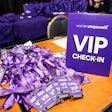As anyone who’s ever sent a professional email knows all too well, figuring out what to say and how to say it is hard work.
There’s a fine line between being assertive and being passive aggressive and finding that line can be a tricky feat. There’s nothing more tempting than throwing a “per my last email” when the person you’re corresponding with clearly ignored your last message or a “moving forward” when someone on your team screws something up,” but all those phrases do is ignite annoyance on the receiving end.
When you toss out condescending phrases, such as “circling back,” you’re not actually articulating a point you’re trying to make; rather, you’re just telling whoever you’re messaging that you are annoyed—not the goal.
Connect sat down with copywriter to creatives and coaches Marisa Corcoran for some guidance on how to make an email both readable and professional.
Eliminate Four-Sentence Paragraph Rule
All throughout school, we’ve been taught to write in a very specific structure, especially when it comes to crafting a carefully curated paragraph. However, there’s something to be said about completely disregarding those rules because, as we age, our attention spans dwindle. With that in mind, who wants to read a huge block of text in their inbox? Corcoran recommends replacing the giant walls of text with short sentences and a two-sentence max per paragraph. Make sure every word you’re saying is pertinent to your point so you don’t lose the reader too early.
Don't Start with the Weather
Don’t waste space in your message with small talk. The point of an email is to convey an exact message to a specific person, so there’s no need to chit chat or warm the recipient up to whatever your ask may be. Corcoran explains, “Be concise with the background needed to support the ask. Make the ask clear. People appreciate the brevity and won't find it rude.” Of course, don’t throw your manners out the window, but don’t feel obligated to ask specifics about their weekend, families or plans for the holidays. A casual “How are you?” will certainly suffice!
Avoid All-Caps at All Costs
“Avoid using CAPS for urgency or to make sure someones sees something. It looks like you're yelling. Use it super sparingly. Instead, bold parts of the email you want to make sure someone reads,” Corcoran says. The eye is naturally drawn to anything that stands out in a crowd and boldface font is no exception. There’s nothing worse than coming across aggressive and angry when you aren’t—especially to co-workers or clients who may not know you very well and could take your all-caps as a bad sign.
Use the Subject Line
It’s there for a reason, people! The purpose of the subject line is to introduce the recipient to your email without diving in. Give the recipient an accurate taste of what’s to come by expressing urgency where needed with words like “deadline,” “please review” and “urgent.” Don’t, however, stress urgency for messages that aren’t time-sensitive.















